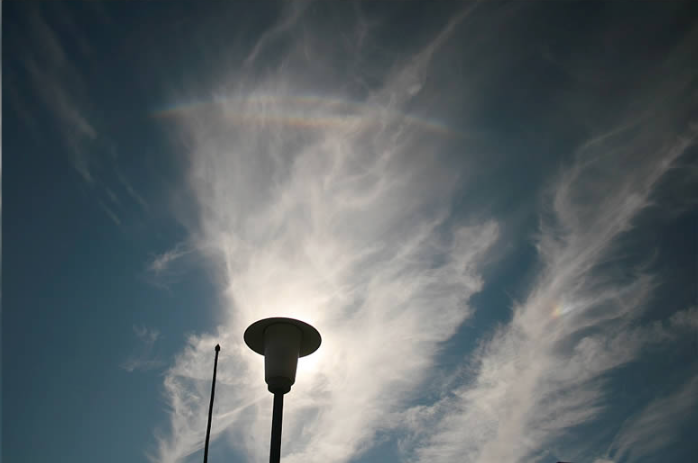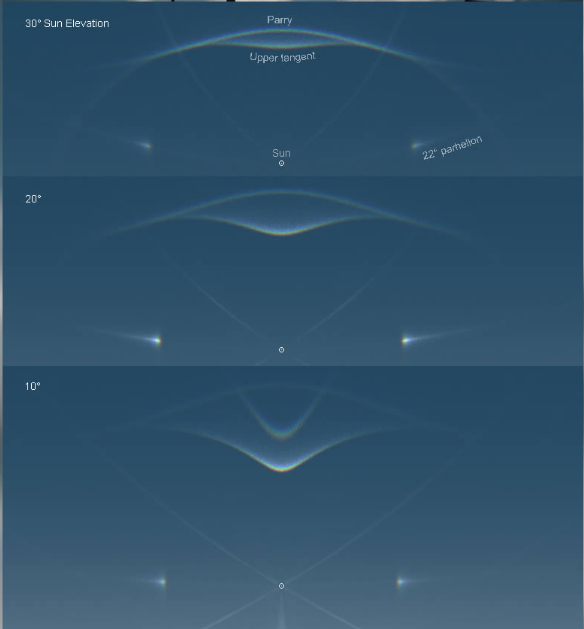Eye in the Sky
Eye in the Sky: Exploring the Phenomenon of Parry Arcs and Upper Tangent Arcs
Atmospheric optics never ceases to amaze us with its captivating displays. One such mesmerizing phenomenon is the formation of a rare Parry arc atop an upper tangent arc, creating what appears to be an "eye in the sky." This remarkable sight is brought about by the alignment of column crystals in a specific manner, with two side faces nearly horizontal. Let's delve deeper into this enchanting atmospheric occurrence and uncover its intricacies.
When observing the "eye in the sky," one might notice the absence of a 22° halo, which is typically associated with sundogs formed by plate crystals. Instead, the focus lies on the Parry arc and the upper tangent arc, both of which exhibit changes in appearance as the sun's elevation varies throughout the day. The Parry arc, characterized by its sharpness and vibrant colors, is always the most prominent feature of this atmospheric spectacle.
To better understand the dynamics at play, HaloSim ray tracing simulations provide valuable insights into the transformation of the Parry arc and upper tangent arc as the sun ascends. As the sun climbs higher in the sky, the gap between these two arcs gradually narrows, altering their visual representation. This evolving configuration adds an element of wonder to the "eye in the sky," making each observation a unique experience.
The formation of Parry arcs and upper tangent arcs is dependent on the alignment of column crystals, which are elongated ice crystals. These crystals have a hexagonal prism shape, and their orientation plays a crucial role in shaping the atmospheric optics display. When these crystals align with two side faces nearly horizontal, they create the distinct "eye" feature that captures our imagination.
It is important to note that Parry arcs are relatively rare compared to other atmospheric optical phenomena. Their occurrence requires specific atmospheric conditions and crystal alignments, making them a fascinating rarity to witness. The intricate interplay of sunlight, ice crystals, and atmospheric conditions brings about these captivating displays, reminding us of the intricate beauty of nature.
The absence of a 22° halo in the presence of the "eye in the sky" can be attributed to the different crystal types involved. While plate crystals are responsible for the formation of sundogs and the accompanying halo, Parry arcs and upper tangent arcs require column crystals with their distinct alignment. This variation in crystal structure leads to the unique optical effects observed in the "eye in the sky" phenomenon.
As enthusiasts of atmospheric optics, we are fortunate to have the opportunity to witness and study these rare occurrences. The "eye in the sky" serves as a reminder of the complex interactions between light and matter in our atmosphere. It highlights the importance of continued research and exploration in understanding the intricacies of atmospheric optics and deepening our appreciation for the wonders that surround us.
In conclusion, the formation of a Parry arc atop an upper tangent arc creates a captivating "eye in the sky" phenomenon. This remarkable display is brought about by the alignment of column crystals with two side faces nearly horizontal. As the sun's elevation changes, the appearance of these arcs evolves, adding an element of mystery and intrigue. While the absence of a 22° halo distinguishes this phenomenon from others, it serves as a reminder of the diverse and awe-inspiring manifestations of atmospheric optics. So, keep your eyes to the sky and be prepared to witness nature's breathtaking wonders unfold before you.


"Eye in the Sky display", Germany, October '08 by Claudia Hinz (Atmospheric Optics site). ©Claudia Hinz, shown with permission.
The "eye" is formed by a rare Parry arc atop an upper tangent arc. Both are formed by column crystals but those making the Parry are more restrictively aligned with two side faces nearly horizontal.
A sundog from plate crystals is at lower right but unusually, there is no 22° halo.
Both the Parry and upper tangent arcs alter their appearance with solar elevation. The HaloSim ray tracing simulations show the changes. As the sun climbs the gap between the two arcs narrows. The parry arc is always the sharpest and has the purer colours.
Note: this article has been automatically converted from the old site and may not appear as intended. You can find the original article here.
Reference Atmospheric Optics
If you use any of the definitions, information, or data presented on Atmospheric Optics, please copy the link or reference below to properly credit us as the reference source. Thank you!
-
<a href="https://atoptics.co.uk/blog/eye-in-the-sky/">Eye in the Sky</a>
-
"Eye in the Sky". Atmospheric Optics. Accessed on November 21, 2024. https://atoptics.co.uk/blog/eye-in-the-sky/.
-
"Eye in the Sky". Atmospheric Optics, https://atoptics.co.uk/blog/eye-in-the-sky/. Accessed 21 November, 2024
-
Eye in the Sky. Atmospheric Optics. Retrieved from https://atoptics.co.uk/blog/eye-in-the-sky/.